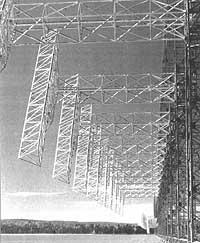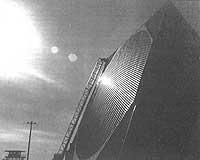Ixilpe and Radar Aircraft

At present, this competition is in full military control, and when attacking weapons acquire some advance, detection systems are impacted by anticipating new inventions.
War planes or strategic missiles are one of their goals to pass undetected. For this purpose they use different techniques, being the most productive: ALAP (or attack auxiliaries), stealth technology and optronic sensors (with reflectance and refraction).
Under the name ALAP are indicated the elements of defrauding or mixing of the enemy detection systems. By dispersing the attractions or forming the fog on the radar, it is intended to divert the attention of the defense observers, rather than pass in secret or in silence.
Another thing is the so-called stealth technology. Using this technology, aircraft leave as little signal as possible in radars. In order for the plane or missionary to be stealth (that is, the closed or clandestine, and not the invisible as many times has been said bad), it has to have a special shape and absorb its covers without reflecting the waves emitted by the radar. As for the form, you have to discard the flat faces, as they reflect the waves with too much goodness. Live edges and tips are also harmful, as surface currents emit energy as an antenna. Dihedron, trihedron and holes do not favor the plane either. In fact, its multiple reflections and refractions can produce catadipic phenomena.
As cover of the plane or missile special materials or paints are used that convert the energy of the radar waves into heat. Thus the waves are not reflected as echoes.
In short, the closing plane, thanks to its shapes and covers, leaves a thousand times less footprint on the detection radars than any other normal aircraft.
However, it is not enough not to reflect the outer waves. It is the Ixilpe plane that needs another radar to detect enemies in the surroundings of the place where it moves or on the ground. And their radar also emits waves, logically, so that others can detect them. The Ixilpe plane, therefore, must carry something different to the radar instead. Low-light television, for example, the light amplification camera explores the outdoor landscape. Infrared sensors record changes and provide images. There are also lidar or laser radars. These emit light, but being so thin, it is practically undetectable.
As expected, warplanes will continue to have detection systems similar to the new divers. These, in addition to their active sonars, also have passive sonars, which allows them to listen without being identified. Warplanes will soon use similar systems, without emitting waves from there. Rather than asking, they will hear the answer.

On the other hand, the images that the pilot will see on his screen will not be taken by the detectors of the same plane. Pilots, radars and remote optronic sensors (lasers, infrared, etc.) scattered across the ground and air will send you numerically encrypted data, allowing you, on the one hand, to hide the shut-off planes and, on the other, to be well informed. Upon warning of the danger, air guards will send the warplane “equipped synthetic tracks”; position, direction, speed, height, etc. of the enemy planes. synthetic images shown.
Although warplanes have the possibility to pass it quieter and more hidden, detection systems have simultaneously undergone great advances. On the one hand, the systems used so far are valid. Also optronic detectors, of course. And thanks to its specifications are rich in information, although it does not serve for long distances.
Ixilpe's planes, for their part, must continue to carry their own radar. The waves emitted by him may be undetectable, but the antenna is mandatory.
When the transmitter is running, the antenna is slightly heated by Joule effect and infrared sensors, which include up to one-tenth of the degree, quickly indicate the location of the radar (hence the plane).
As a result, flying radar stations (AWACS or Hawkeye) can be expected to soon have other optronic stations. Today, in addition, radar and optronic elements can be used in sensors together, and if the closing plane defrauds a system, the other will report.
However, Ixilpe aircraft are better protected than below. Landing gear, motor housings, body and wing joints, etc. and radar waves are not properly reflected. But the waves that come above the plane, and NASA wants to detect from space its enemies. They also want to diversify detection systems to prevent all eggs from being in the same basket (ground). To this they have called precisely the “war of the galaxies” in recent times and this topic has been treated in this same magazine Elhuyar (see “Pakea of the deserts” M.J. I Irazabalbeitia railing. Elhuyar 11-1. pag51 1985).

It seems they will use three types of space radars. In January 1984, the US Air Navy proposed placing twenty radars on the satellites. These radars would be at a height of 2,800 kilometers (non-geostable orbit). Each of these twenty stations would have a detection capacity of up to 6,000 kilometers and the spy system 50 million square kilometers of the Earth.
In the second system, small coordinated radars would be like satellites. This project, known as DSA (Distributed Space Array), would have greater accuracy in detecting the targets of enemies. The presence of many radars, on the other hand, means that the whole would be more protected from anti-satellite weapons.
The third project is the so-called “visible” system. The radar would be installed on the satellite and the radiation receivers would be on large planes. In this system the radars are smaller and lighter and the reflected waves do not need to be recovered in the satellite, as they are received in large planes. These planes would pass over the closing plane and be mere receptors of the waves. They may also include optronic detection systems.
It is clear that the military powers are confronting and protecting themselves from mutual attacks. For this they have desire, abilities, imagination, money and means.
Buletina
Bidali zure helbide elektronikoa eta jaso asteroko buletina zure sarrera-ontzian











